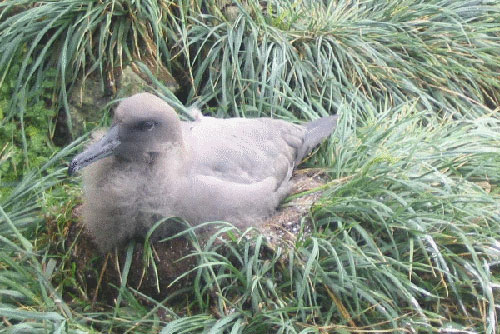A cliff-hanger is properly a suspenseful break in or an end to an entertainment series that is meant to encourage viewers to look out for the sequel; it is said to come from early films when the hero was often left literally hanging over a cliff. Cliff-hanging is also what is needed to study the Sooty Albatrosses Phoebetria fusca on the United Kingdom's Gough Island which mainly breed on the island's coastal cliffs, their nests often overhanging precipitous drops into the cold and rough South Atlantic below.
In 2010 I started what I thought would be the my last demographic study, of Southern Giant Petrels Macronectes giganteus on Gough Island (click here), following earlier studies set up on Gough's Atlantic Yellow-nosed Albatrosses Thalassarche chlororhynchos in 1982 and Tristan Albatrosses Diomedea dabbenena in 2007 (click here).
However, I have been back on Gough once more this and last month (my 17th visit) for the annual relief of the South African weather station, and at the request of Peter Ryan of the University of Cape Town's Percy FitzPatrick Institute of African Ornithology, have with colleagues been setting up yet another demographic study,this time on ACAP-listed Sooty Albatrosses. Gough Island holds a significant part (perhaps more than a third) of the global population of this relatively little-studied albatross and the new study aims to learn more about its breeding and foraging.
Clambering around Gough's cliffs is inherently dangerous and so we used fixed ropes to reach the more exposed nests in safety. On 28 September we found the first egg of the season after a week of colour- and metal-banded birds, thought to be mainly males by bill measurements, on empty nests.
The idea is to follow at least 20 breeding pairs a year of this biennially breeding species initially. This has required some searching as many nests conveniently close to the weather station in Transvaal Bay are only accessible to qualified rope-access technicians. Care when handling and banding breeding birds also has to be taken as Sooties are somewhat "flighty", and could easily loose their eggs to Subantarctic Skuas Catharacta antarctica if they take to the air when incubating.
By the time we left the island on 3 October, 52 birds had been colour-banded and seven eggs laid. The year team will now continue the new study.

A Sooty Albatross chick starts to lose its down
Photograph by Marienne de Villiers
With thanks to Chris Bell, Jan Bradley, Mara Nydegger, Aleks Terauds and Paul Visser for help in the field.
Seelcted references:
Cuthbert, R.J. & Sommer, E.S. 2004. Population size and trends of four globally threatened seabirds at Gough Island, South Atlantic Ocean. Marine Ornithology 32: 97-103.
Cuthbert, R.[J.] & Sommer, E.[S.] 2004. Gough Island Bird Monitoring Manual. RSPB Research Report No. 5. 52 pp.
Wolfaardt, A.C., Glass, J. & Glass, T. 2009. Tristan da Cunha Implementation Plan for the Agreement on the Conservation of Albatrosses and Petrels (ACAP): Review of Current Work and a Prioritised Work Programme for the Future. Edinburgh, Tristan da Cunha: Tristan da Cunha Government.
John Cooper, ACAP Information Officer, 9 October 2012, South Atlantic aboard the S.A. Agulhas II

 English
English  Français
Français  Español
Español